An Analysis of Social Media Marketing Theories with Articles
VerifiedAdded on 2023/01/19
|7
|1689
|21
Essay
AI Summary
This essay delves into the complex landscape of social media marketing, examining its potential and various theoretical frameworks. It explores personal behavior theories, such as the Theory of Reasoned Action and its application to blog usage and green information technology acceptance. The essay also analyzes social behavior theories, focusing on cognitive mapping and its role in understanding online community behavior and travel behavior. Furthermore, it investigates mass communication theories, particularly the parasocial interaction theory and its impact on consumer-brand relationships. The analysis is supported by a comparative study of six different articles, highlighting the key concepts and contrasting perspectives within each theory. The conclusion emphasizes the importance of these theories in explaining user behavior and leveraging the virtual platform for effective marketing and advertising strategies.
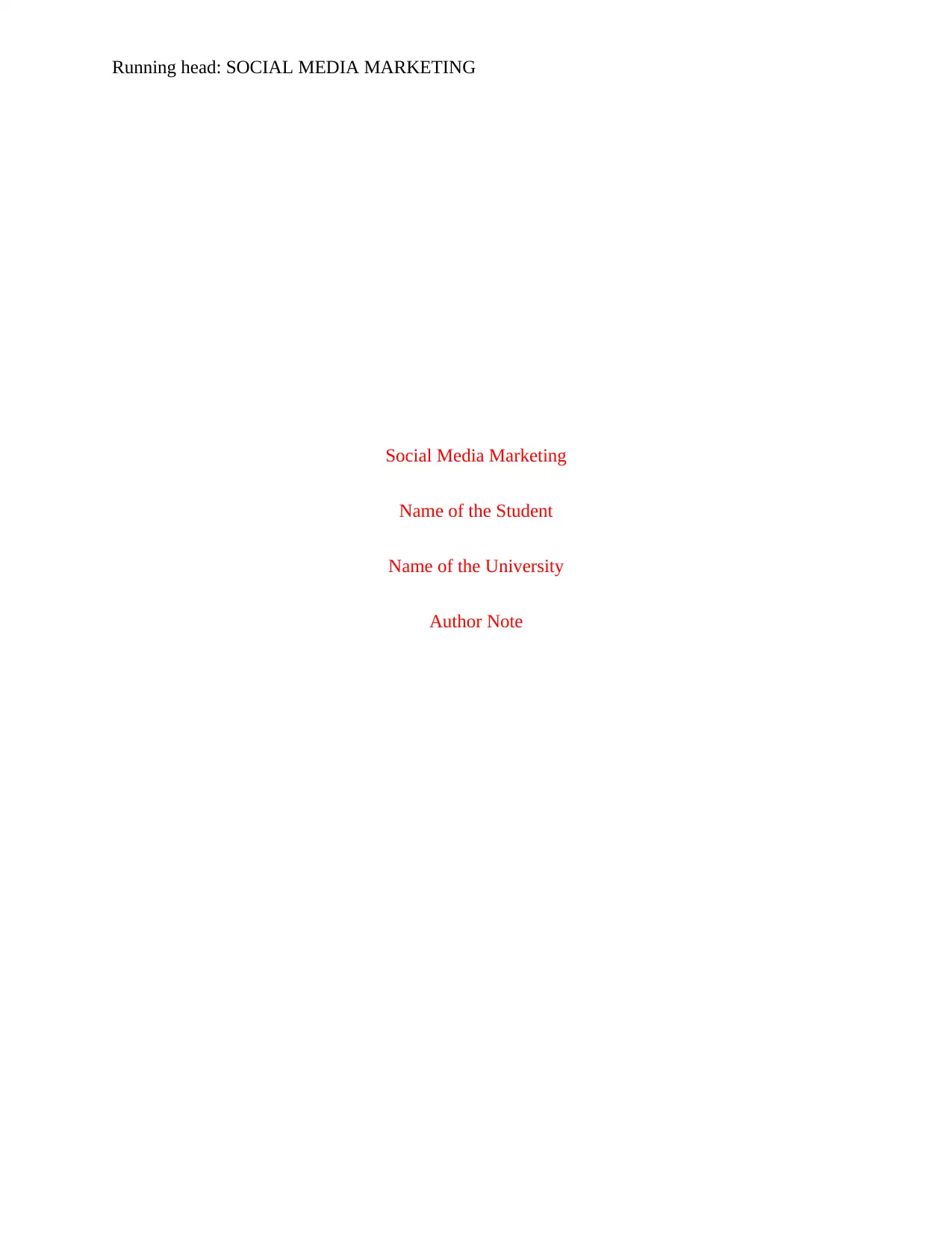
Running head: SOCIAL MEDIA MARKETING
Social Media Marketing
Name of the Student
Name of the University
Author Note
Social Media Marketing
Name of the Student
Name of the University
Author Note
Paraphrase This Document
Need a fresh take? Get an instant paraphrase of this document with our AI Paraphraser
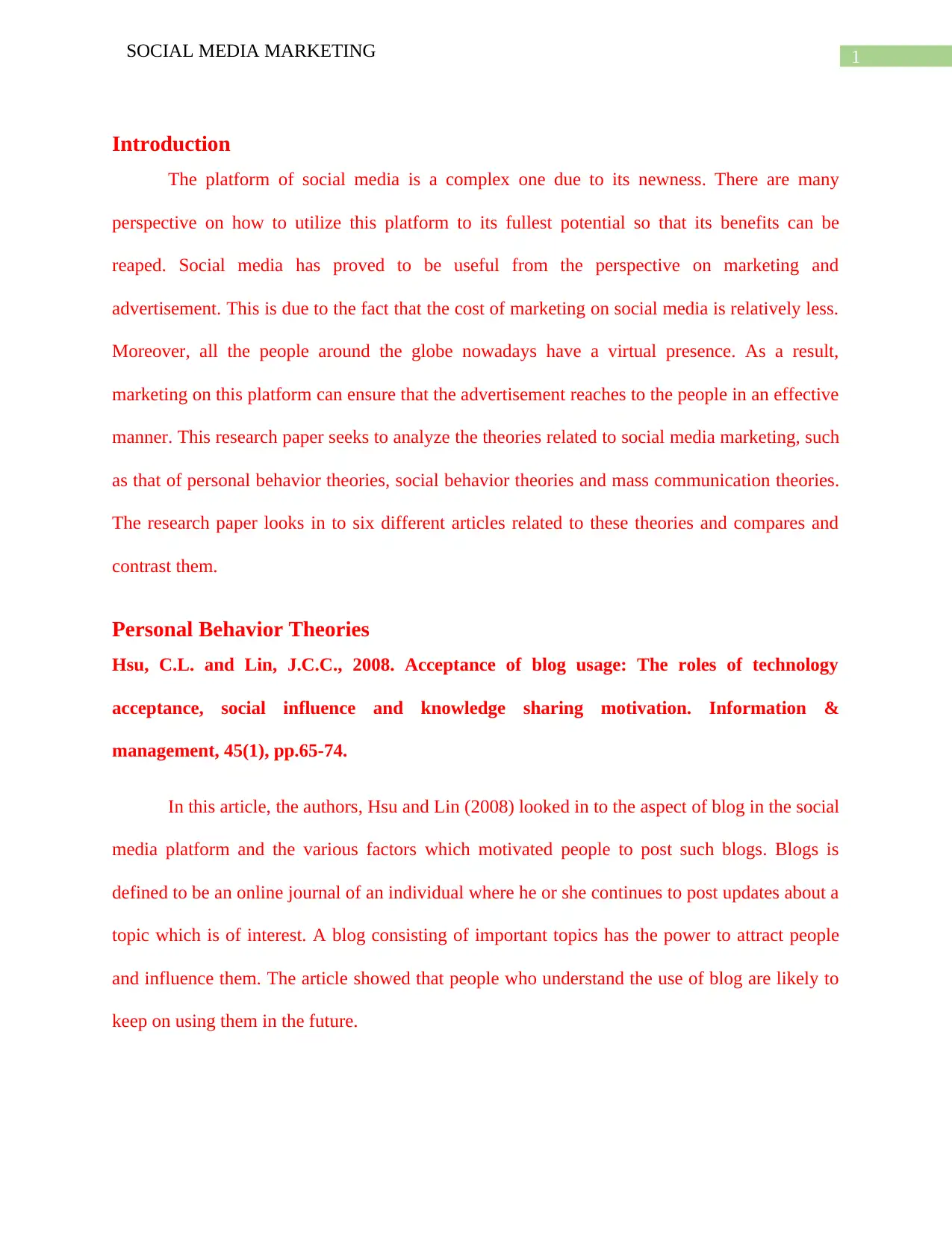
1SOCIAL MEDIA MARKETING
Introduction
The platform of social media is a complex one due to its newness. There are many
perspective on how to utilize this platform to its fullest potential so that its benefits can be
reaped. Social media has proved to be useful from the perspective on marketing and
advertisement. This is due to the fact that the cost of marketing on social media is relatively less.
Moreover, all the people around the globe nowadays have a virtual presence. As a result,
marketing on this platform can ensure that the advertisement reaches to the people in an effective
manner. This research paper seeks to analyze the theories related to social media marketing, such
as that of personal behavior theories, social behavior theories and mass communication theories.
The research paper looks in to six different articles related to these theories and compares and
contrast them.
Personal Behavior Theories
Hsu, C.L. and Lin, J.C.C., 2008. Acceptance of blog usage: The roles of technology
acceptance, social influence and knowledge sharing motivation. Information &
management, 45(1), pp.65-74.
In this article, the authors, Hsu and Lin (2008) looked in to the aspect of blog in the social
media platform and the various factors which motivated people to post such blogs. Blogs is
defined to be an online journal of an individual where he or she continues to post updates about a
topic which is of interest. A blog consisting of important topics has the power to attract people
and influence them. The article showed that people who understand the use of blog are likely to
keep on using them in the future.
Introduction
The platform of social media is a complex one due to its newness. There are many
perspective on how to utilize this platform to its fullest potential so that its benefits can be
reaped. Social media has proved to be useful from the perspective on marketing and
advertisement. This is due to the fact that the cost of marketing on social media is relatively less.
Moreover, all the people around the globe nowadays have a virtual presence. As a result,
marketing on this platform can ensure that the advertisement reaches to the people in an effective
manner. This research paper seeks to analyze the theories related to social media marketing, such
as that of personal behavior theories, social behavior theories and mass communication theories.
The research paper looks in to six different articles related to these theories and compares and
contrast them.
Personal Behavior Theories
Hsu, C.L. and Lin, J.C.C., 2008. Acceptance of blog usage: The roles of technology
acceptance, social influence and knowledge sharing motivation. Information &
management, 45(1), pp.65-74.
In this article, the authors, Hsu and Lin (2008) looked in to the aspect of blog in the social
media platform and the various factors which motivated people to post such blogs. Blogs is
defined to be an online journal of an individual where he or she continues to post updates about a
topic which is of interest. A blog consisting of important topics has the power to attract people
and influence them. The article showed that people who understand the use of blog are likely to
keep on using them in the future.
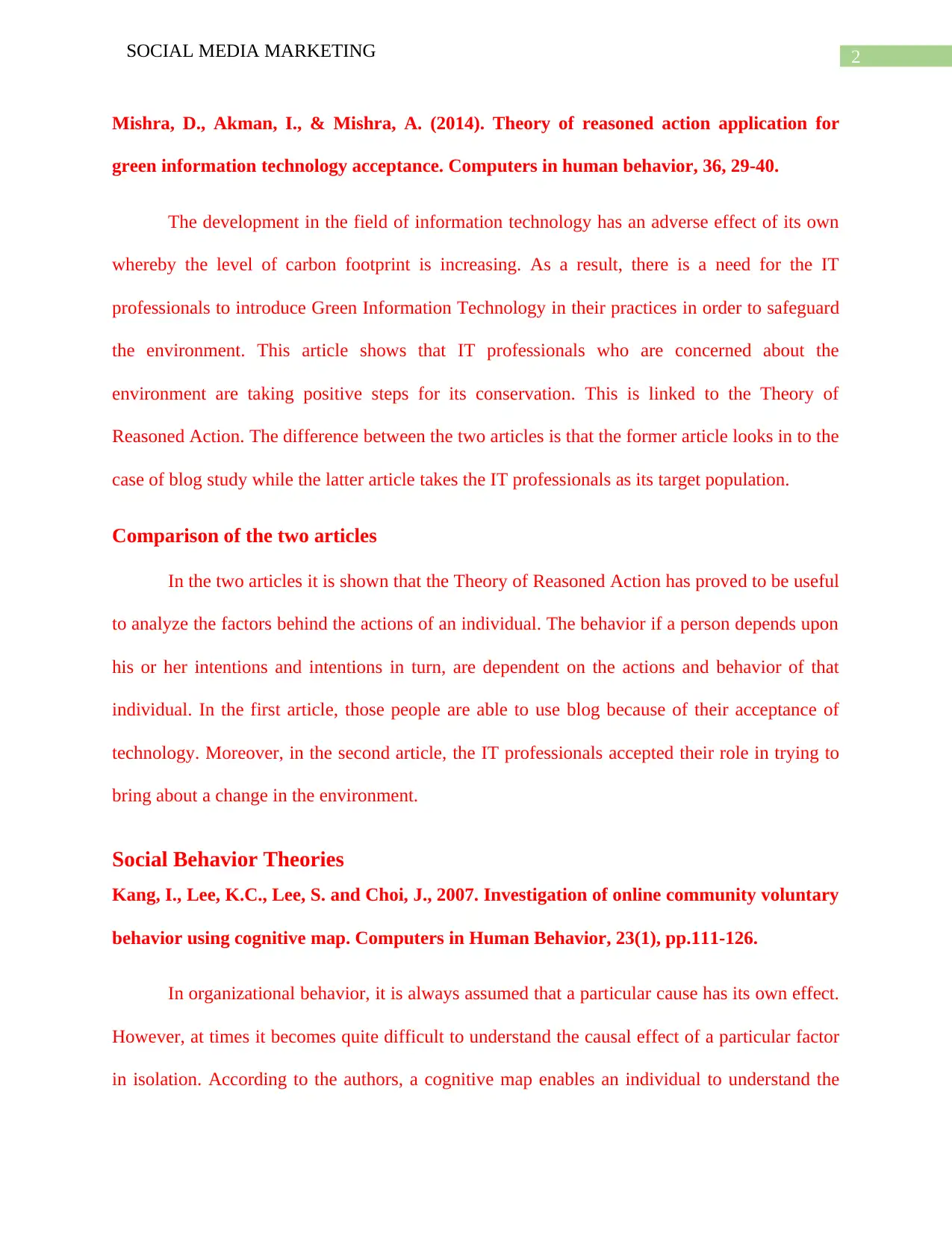
2SOCIAL MEDIA MARKETING
Mishra, D., Akman, I., & Mishra, A. (2014). Theory of reasoned action application for
green information technology acceptance. Computers in human behavior, 36, 29-40.
The development in the field of information technology has an adverse effect of its own
whereby the level of carbon footprint is increasing. As a result, there is a need for the IT
professionals to introduce Green Information Technology in their practices in order to safeguard
the environment. This article shows that IT professionals who are concerned about the
environment are taking positive steps for its conservation. This is linked to the Theory of
Reasoned Action. The difference between the two articles is that the former article looks in to the
case of blog study while the latter article takes the IT professionals as its target population.
Comparison of the two articles
In the two articles it is shown that the Theory of Reasoned Action has proved to be useful
to analyze the factors behind the actions of an individual. The behavior if a person depends upon
his or her intentions and intentions in turn, are dependent on the actions and behavior of that
individual. In the first article, those people are able to use blog because of their acceptance of
technology. Moreover, in the second article, the IT professionals accepted their role in trying to
bring about a change in the environment.
Social Behavior Theories
Kang, I., Lee, K.C., Lee, S. and Choi, J., 2007. Investigation of online community voluntary
behavior using cognitive map. Computers in Human Behavior, 23(1), pp.111-126.
In organizational behavior, it is always assumed that a particular cause has its own effect.
However, at times it becomes quite difficult to understand the causal effect of a particular factor
in isolation. According to the authors, a cognitive map enables an individual to understand the
Mishra, D., Akman, I., & Mishra, A. (2014). Theory of reasoned action application for
green information technology acceptance. Computers in human behavior, 36, 29-40.
The development in the field of information technology has an adverse effect of its own
whereby the level of carbon footprint is increasing. As a result, there is a need for the IT
professionals to introduce Green Information Technology in their practices in order to safeguard
the environment. This article shows that IT professionals who are concerned about the
environment are taking positive steps for its conservation. This is linked to the Theory of
Reasoned Action. The difference between the two articles is that the former article looks in to the
case of blog study while the latter article takes the IT professionals as its target population.
Comparison of the two articles
In the two articles it is shown that the Theory of Reasoned Action has proved to be useful
to analyze the factors behind the actions of an individual. The behavior if a person depends upon
his or her intentions and intentions in turn, are dependent on the actions and behavior of that
individual. In the first article, those people are able to use blog because of their acceptance of
technology. Moreover, in the second article, the IT professionals accepted their role in trying to
bring about a change in the environment.
Social Behavior Theories
Kang, I., Lee, K.C., Lee, S. and Choi, J., 2007. Investigation of online community voluntary
behavior using cognitive map. Computers in Human Behavior, 23(1), pp.111-126.
In organizational behavior, it is always assumed that a particular cause has its own effect.
However, at times it becomes quite difficult to understand the causal effect of a particular factor
in isolation. According to the authors, a cognitive map enables an individual to understand the
⊘ This is a preview!⊘
Do you want full access?
Subscribe today to unlock all pages.

Trusted by 1+ million students worldwide
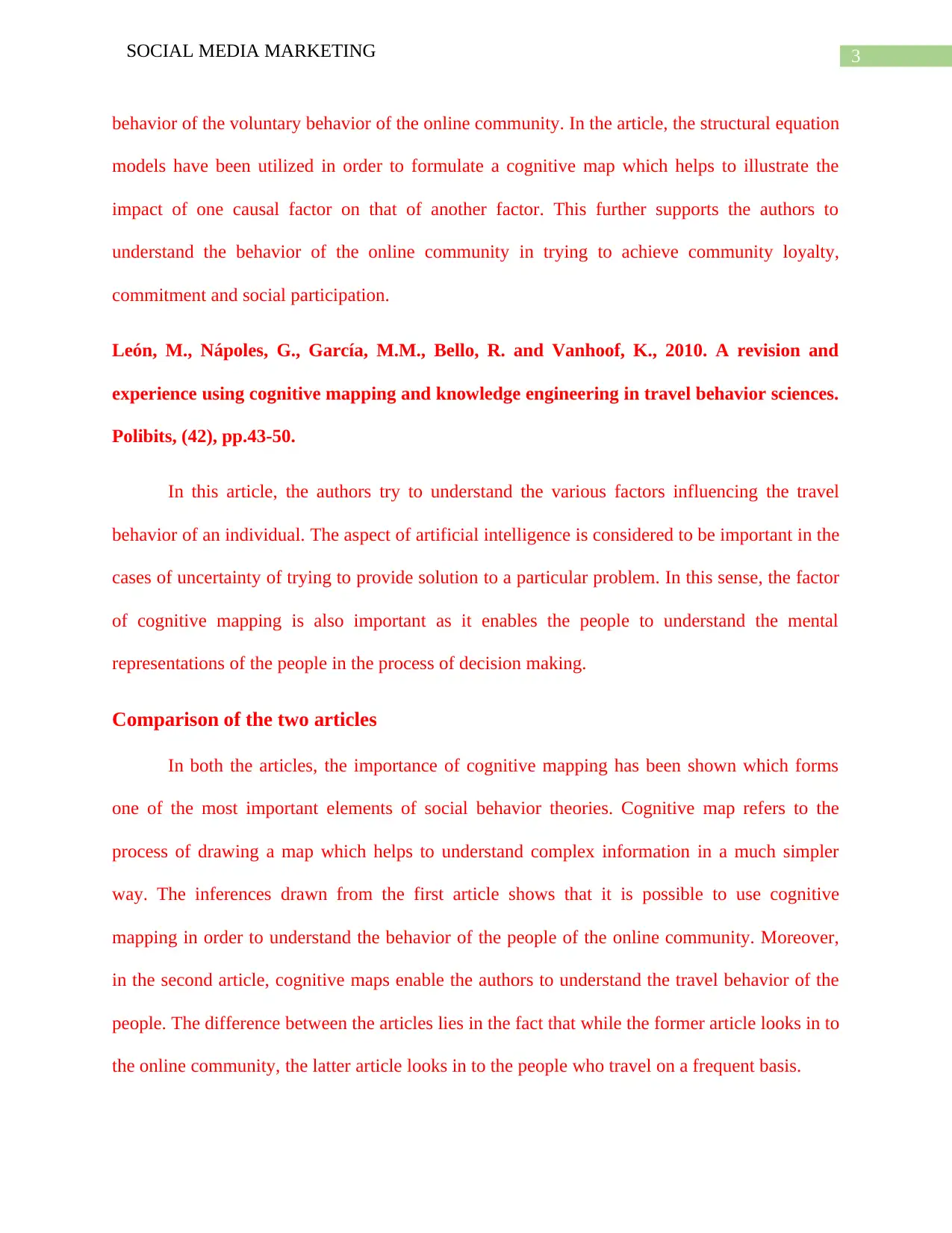
3SOCIAL MEDIA MARKETING
behavior of the voluntary behavior of the online community. In the article, the structural equation
models have been utilized in order to formulate a cognitive map which helps to illustrate the
impact of one causal factor on that of another factor. This further supports the authors to
understand the behavior of the online community in trying to achieve community loyalty,
commitment and social participation.
León, M., Nápoles, G., García, M.M., Bello, R. and Vanhoof, K., 2010. A revision and
experience using cognitive mapping and knowledge engineering in travel behavior sciences.
Polibits, (42), pp.43-50.
In this article, the authors try to understand the various factors influencing the travel
behavior of an individual. The aspect of artificial intelligence is considered to be important in the
cases of uncertainty of trying to provide solution to a particular problem. In this sense, the factor
of cognitive mapping is also important as it enables the people to understand the mental
representations of the people in the process of decision making.
Comparison of the two articles
In both the articles, the importance of cognitive mapping has been shown which forms
one of the most important elements of social behavior theories. Cognitive map refers to the
process of drawing a map which helps to understand complex information in a much simpler
way. The inferences drawn from the first article shows that it is possible to use cognitive
mapping in order to understand the behavior of the people of the online community. Moreover,
in the second article, cognitive maps enable the authors to understand the travel behavior of the
people. The difference between the articles lies in the fact that while the former article looks in to
the online community, the latter article looks in to the people who travel on a frequent basis.
behavior of the voluntary behavior of the online community. In the article, the structural equation
models have been utilized in order to formulate a cognitive map which helps to illustrate the
impact of one causal factor on that of another factor. This further supports the authors to
understand the behavior of the online community in trying to achieve community loyalty,
commitment and social participation.
León, M., Nápoles, G., García, M.M., Bello, R. and Vanhoof, K., 2010. A revision and
experience using cognitive mapping and knowledge engineering in travel behavior sciences.
Polibits, (42), pp.43-50.
In this article, the authors try to understand the various factors influencing the travel
behavior of an individual. The aspect of artificial intelligence is considered to be important in the
cases of uncertainty of trying to provide solution to a particular problem. In this sense, the factor
of cognitive mapping is also important as it enables the people to understand the mental
representations of the people in the process of decision making.
Comparison of the two articles
In both the articles, the importance of cognitive mapping has been shown which forms
one of the most important elements of social behavior theories. Cognitive map refers to the
process of drawing a map which helps to understand complex information in a much simpler
way. The inferences drawn from the first article shows that it is possible to use cognitive
mapping in order to understand the behavior of the people of the online community. Moreover,
in the second article, cognitive maps enable the authors to understand the travel behavior of the
people. The difference between the articles lies in the fact that while the former article looks in to
the online community, the latter article looks in to the people who travel on a frequent basis.
Paraphrase This Document
Need a fresh take? Get an instant paraphrase of this document with our AI Paraphraser
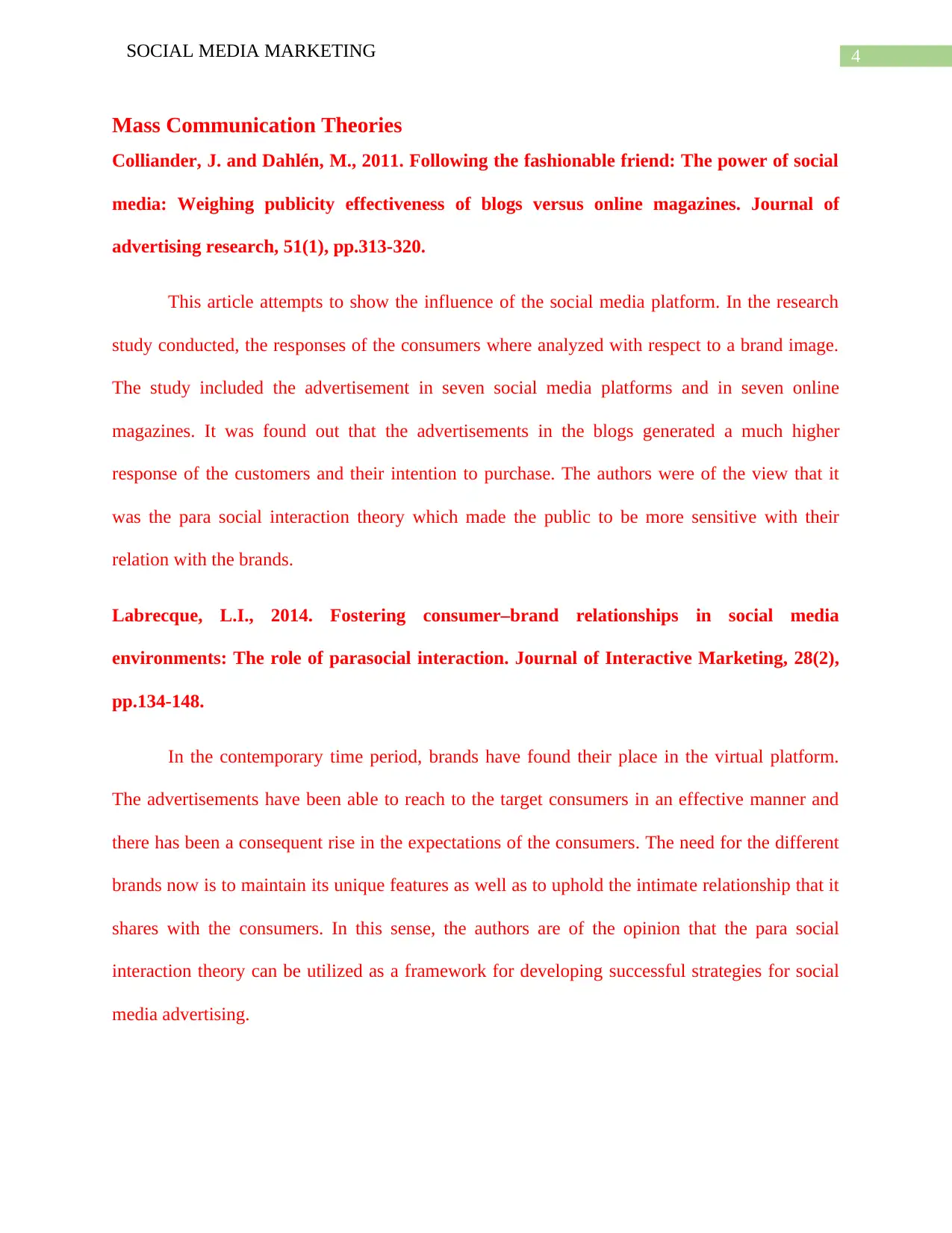
4SOCIAL MEDIA MARKETING
Mass Communication Theories
Colliander, J. and Dahlén, M., 2011. Following the fashionable friend: The power of social
media: Weighing publicity effectiveness of blogs versus online magazines. Journal of
advertising research, 51(1), pp.313-320.
This article attempts to show the influence of the social media platform. In the research
study conducted, the responses of the consumers where analyzed with respect to a brand image.
The study included the advertisement in seven social media platforms and in seven online
magazines. It was found out that the advertisements in the blogs generated a much higher
response of the customers and their intention to purchase. The authors were of the view that it
was the para social interaction theory which made the public to be more sensitive with their
relation with the brands.
Labrecque, L.I., 2014. Fostering consumer–brand relationships in social media
environments: The role of parasocial interaction. Journal of Interactive Marketing, 28(2),
pp.134-148.
In the contemporary time period, brands have found their place in the virtual platform.
The advertisements have been able to reach to the target consumers in an effective manner and
there has been a consequent rise in the expectations of the consumers. The need for the different
brands now is to maintain its unique features as well as to uphold the intimate relationship that it
shares with the consumers. In this sense, the authors are of the opinion that the para social
interaction theory can be utilized as a framework for developing successful strategies for social
media advertising.
Mass Communication Theories
Colliander, J. and Dahlén, M., 2011. Following the fashionable friend: The power of social
media: Weighing publicity effectiveness of blogs versus online magazines. Journal of
advertising research, 51(1), pp.313-320.
This article attempts to show the influence of the social media platform. In the research
study conducted, the responses of the consumers where analyzed with respect to a brand image.
The study included the advertisement in seven social media platforms and in seven online
magazines. It was found out that the advertisements in the blogs generated a much higher
response of the customers and their intention to purchase. The authors were of the view that it
was the para social interaction theory which made the public to be more sensitive with their
relation with the brands.
Labrecque, L.I., 2014. Fostering consumer–brand relationships in social media
environments: The role of parasocial interaction. Journal of Interactive Marketing, 28(2),
pp.134-148.
In the contemporary time period, brands have found their place in the virtual platform.
The advertisements have been able to reach to the target consumers in an effective manner and
there has been a consequent rise in the expectations of the consumers. The need for the different
brands now is to maintain its unique features as well as to uphold the intimate relationship that it
shares with the consumers. In this sense, the authors are of the opinion that the para social
interaction theory can be utilized as a framework for developing successful strategies for social
media advertising.
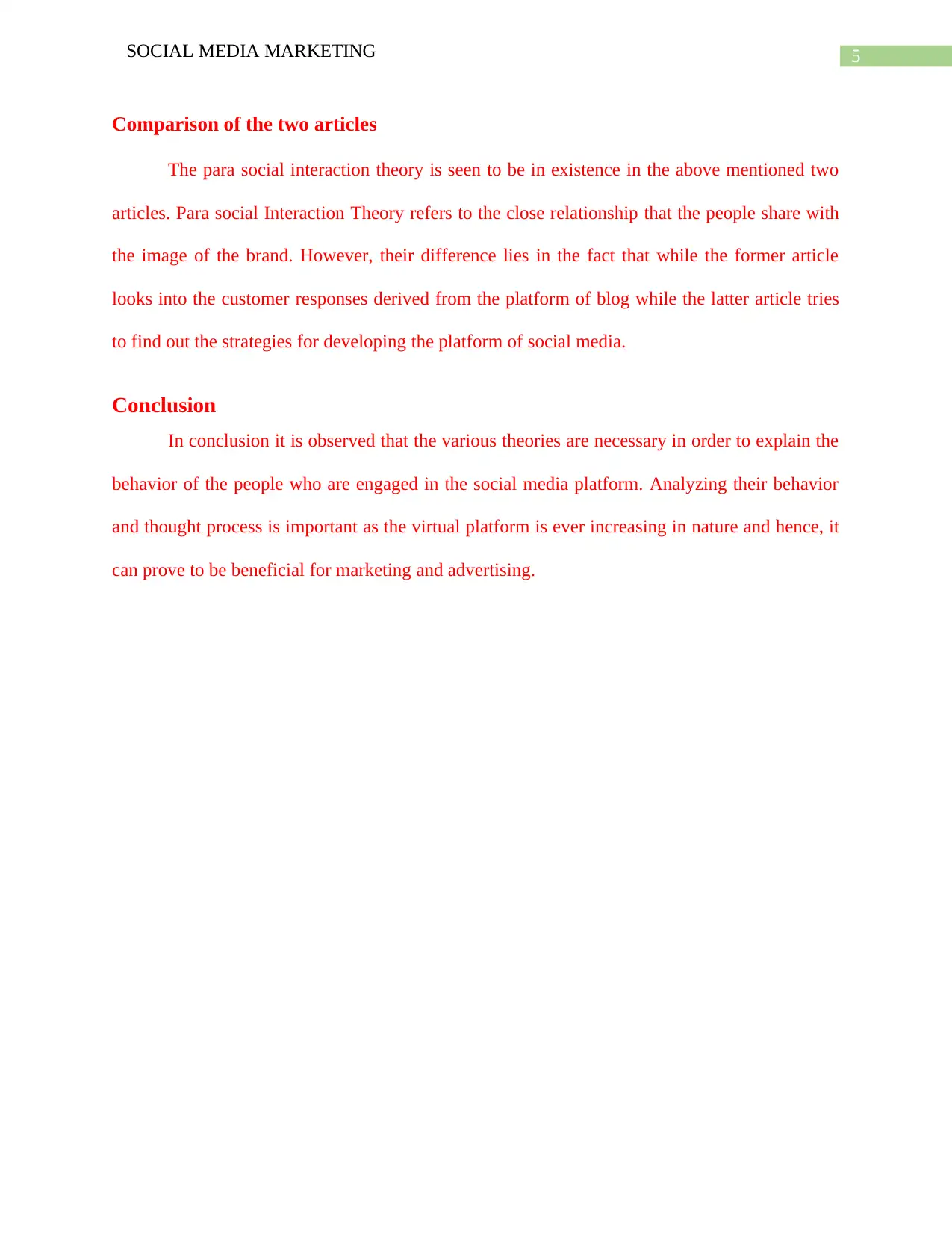
5SOCIAL MEDIA MARKETING
Comparison of the two articles
The para social interaction theory is seen to be in existence in the above mentioned two
articles. Para social Interaction Theory refers to the close relationship that the people share with
the image of the brand. However, their difference lies in the fact that while the former article
looks into the customer responses derived from the platform of blog while the latter article tries
to find out the strategies for developing the platform of social media.
Conclusion
In conclusion it is observed that the various theories are necessary in order to explain the
behavior of the people who are engaged in the social media platform. Analyzing their behavior
and thought process is important as the virtual platform is ever increasing in nature and hence, it
can prove to be beneficial for marketing and advertising.
Comparison of the two articles
The para social interaction theory is seen to be in existence in the above mentioned two
articles. Para social Interaction Theory refers to the close relationship that the people share with
the image of the brand. However, their difference lies in the fact that while the former article
looks into the customer responses derived from the platform of blog while the latter article tries
to find out the strategies for developing the platform of social media.
Conclusion
In conclusion it is observed that the various theories are necessary in order to explain the
behavior of the people who are engaged in the social media platform. Analyzing their behavior
and thought process is important as the virtual platform is ever increasing in nature and hence, it
can prove to be beneficial for marketing and advertising.
⊘ This is a preview!⊘
Do you want full access?
Subscribe today to unlock all pages.

Trusted by 1+ million students worldwide
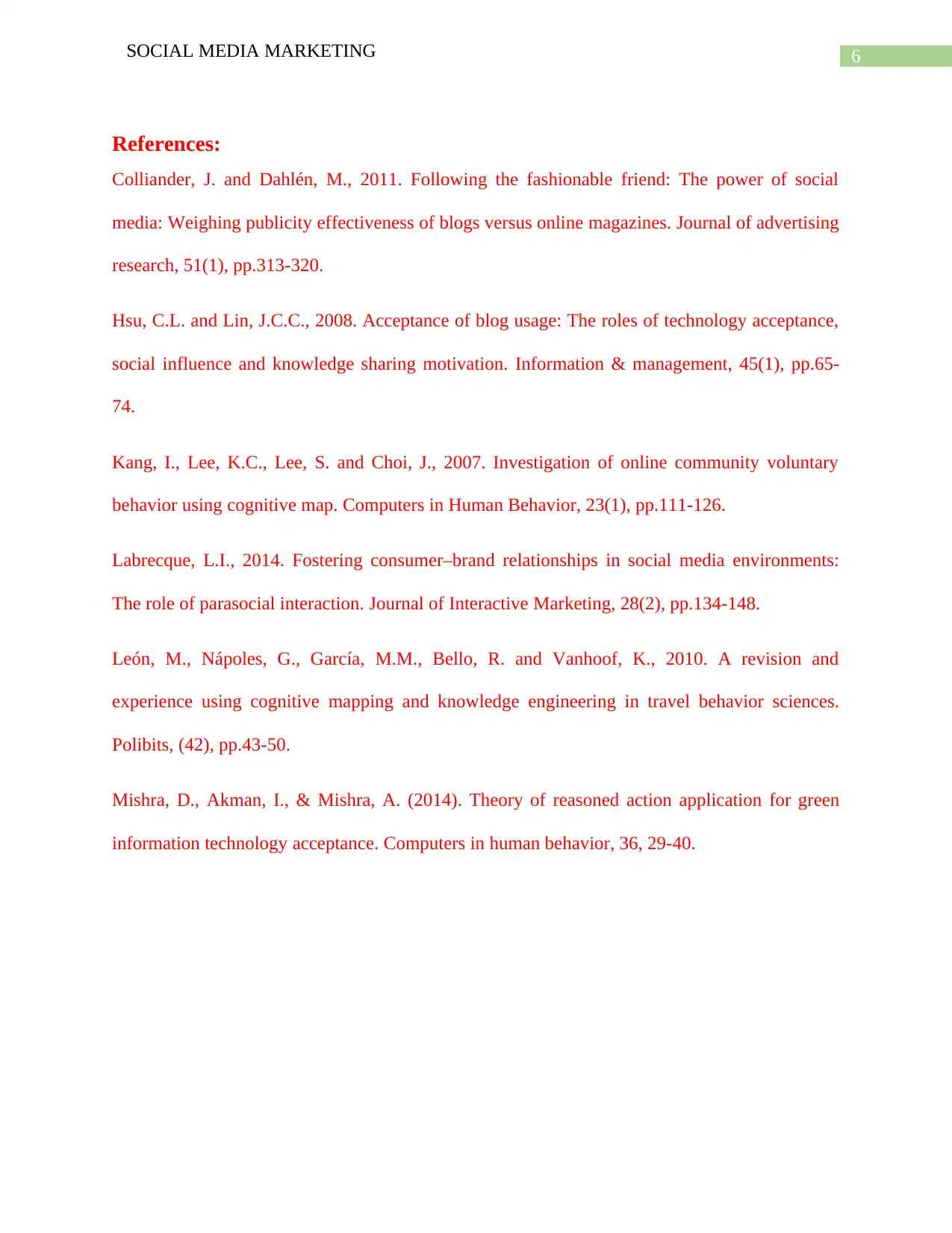
6SOCIAL MEDIA MARKETING
References:
Colliander, J. and Dahlén, M., 2011. Following the fashionable friend: The power of social
media: Weighing publicity effectiveness of blogs versus online magazines. Journal of advertising
research, 51(1), pp.313-320.
Hsu, C.L. and Lin, J.C.C., 2008. Acceptance of blog usage: The roles of technology acceptance,
social influence and knowledge sharing motivation. Information & management, 45(1), pp.65-
74.
Kang, I., Lee, K.C., Lee, S. and Choi, J., 2007. Investigation of online community voluntary
behavior using cognitive map. Computers in Human Behavior, 23(1), pp.111-126.
Labrecque, L.I., 2014. Fostering consumer–brand relationships in social media environments:
The role of parasocial interaction. Journal of Interactive Marketing, 28(2), pp.134-148.
León, M., Nápoles, G., García, M.M., Bello, R. and Vanhoof, K., 2010. A revision and
experience using cognitive mapping and knowledge engineering in travel behavior sciences.
Polibits, (42), pp.43-50.
Mishra, D., Akman, I., & Mishra, A. (2014). Theory of reasoned action application for green
information technology acceptance. Computers in human behavior, 36, 29-40.
References:
Colliander, J. and Dahlén, M., 2011. Following the fashionable friend: The power of social
media: Weighing publicity effectiveness of blogs versus online magazines. Journal of advertising
research, 51(1), pp.313-320.
Hsu, C.L. and Lin, J.C.C., 2008. Acceptance of blog usage: The roles of technology acceptance,
social influence and knowledge sharing motivation. Information & management, 45(1), pp.65-
74.
Kang, I., Lee, K.C., Lee, S. and Choi, J., 2007. Investigation of online community voluntary
behavior using cognitive map. Computers in Human Behavior, 23(1), pp.111-126.
Labrecque, L.I., 2014. Fostering consumer–brand relationships in social media environments:
The role of parasocial interaction. Journal of Interactive Marketing, 28(2), pp.134-148.
León, M., Nápoles, G., García, M.M., Bello, R. and Vanhoof, K., 2010. A revision and
experience using cognitive mapping and knowledge engineering in travel behavior sciences.
Polibits, (42), pp.43-50.
Mishra, D., Akman, I., & Mishra, A. (2014). Theory of reasoned action application for green
information technology acceptance. Computers in human behavior, 36, 29-40.
1 out of 7
Related Documents
Your All-in-One AI-Powered Toolkit for Academic Success.
+13062052269
info@desklib.com
Available 24*7 on WhatsApp / Email
![[object Object]](/_next/static/media/star-bottom.7253800d.svg)
Unlock your academic potential
Copyright © 2020–2025 A2Z Services. All Rights Reserved. Developed and managed by ZUCOL.





